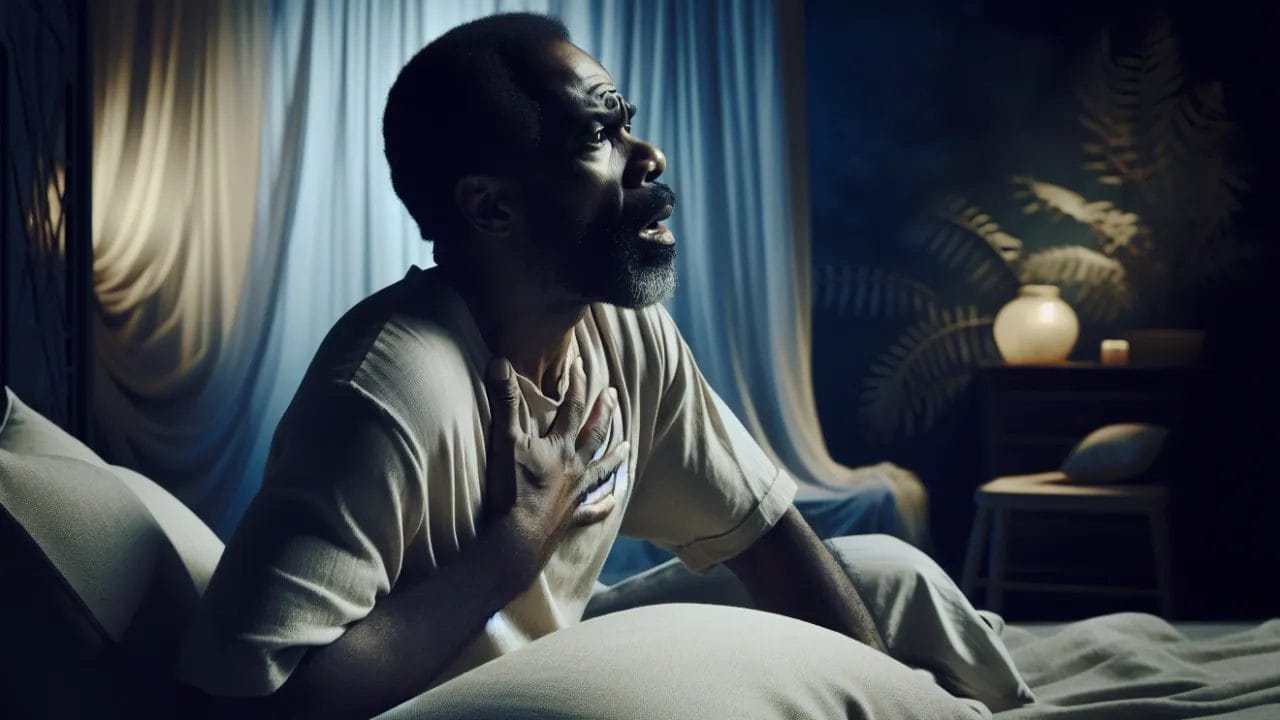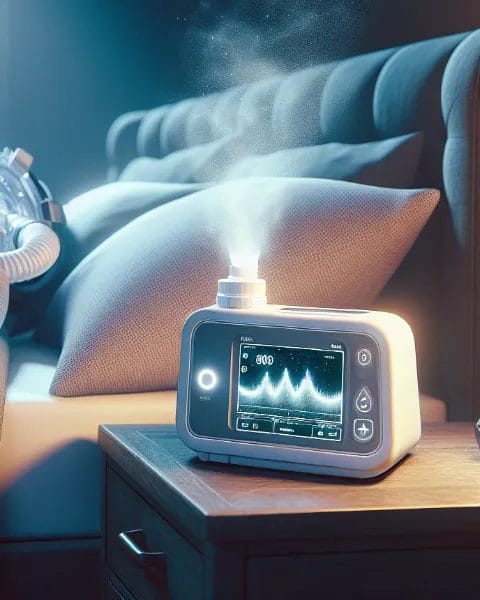Can Sleep Apnea Kill You? | Danger in Your Noisy Bedroom
In the quiet of the night, a battle rages on in bedrooms across America. It’s not the latest thriller playing on Netflix, nor is it the age-old dispute over the thermostat setting.
It’s something far more insidious, and may be happening right under your noses—quite literally. Welcome to the world of obstructive sleep apnea (OSA), a condition that affects as many as 45% of American adults, turning their snores into silent alarms for underlying health battles.
Snores and Misconceptions
The symphony of snoring, often dismissed as a minor annoyance (primarily by those not sharing the bed), masks a potentially grave health risk. This is not just about the decibel levels that can rival a small chainsaw; it’s about what those snores signify.
Many people view snoring through the lens of social inconvenience, a trivial matter more embarrassing than worrisome. Yet, lurking beneath this cacophony is a condition that can play a nefarious role in your health, far beyond the reaches of the bedroom.
A Wake-Up Call on Sleep Apnea
Sleep apnea isn’t just a fancy term for snoring louder than your neighbor’s lawnmower. It’s a serious condition where the battle for breath turns into a nightly saga of survival. Imagine trying to sip air through a straw while someone intermittently pinches it closed.
Not so fun, right? That’s a night in the life of someone with sleep apnea. But it’s not just about the struggle for oxygen; it’s about the domino effect this condition can have on your health, from turning your blood pressure into a ticking time bomb to making your heart work overtime.
The Health Risks: Beyond the Zzz’s
It’s easy to brush off sleep apnea as merely a sleep quality issue, but it’s more like the tip of an iceberg with health risks that run deep and wide. This condition sneaks past your body’s defenses, inviting a host of unwanted guests like high blood pressure, heart disease, and even type 2 diabetes to the party.
And the worst part? Many don’t even know they’re hosting this dangerous soiree until the effects are too glaring to ignore.
The Unseen Battle: Inside the World of Obstructive Sleep Apnea
Imagine, if you will, a nightly drama unfolding in the dark, where the main character is you, but one you’re not fully aware of—a version of you that fights for every breath while the rest of you sleeps. This is the nightly reality for those with obstructive sleep apnea (OSA), a condition as common as it is misunderstood.
What Exactly Is Obstructive Sleep Apnea?
At its core, OSA is what happens when the upper airway says, “I quit!” and collapses, turning breathing into an act of defiance. These pauses in breathing, known as apneas, are the body’s way of throwing a wrench into the works of what should be a peaceful night’s sleep.
Each pause is a mini-drama, a suspenseful moment where breathing stops, oxygen levels drop, and the body has to kick itself awake (just a bit) to resume breathing. It’s a plot twist that happens hundreds of times a night, and the worst part? The sleeper is none the wiser.
Recognizing the Villain: Symptoms of Sleep Apnea
The signs of sleep apnea are as subtle as they are sinister. Snoring, yes, but it’s more than just the soundtrack of sleep apnea; it’s one of the leading indicators that the airway is putting up a fight.
Then there’s the daytime fatigue, a level of tiredness that makes a triple-shot espresso look like child’s play. And let’s not forget the mysterious case of the morning headaches, the body’s way of saying, “Hey, we didn’t get enough oxygen last night!”
The Plot Thickens: The Health Risks of Ignoring Sleep Apnea
The real drama begins when sleep apnea goes unaddressed, sneaking past the body’s defenses and laying the groundwork for a series of health crises. It’s like leaving the back door open for a variety of unwelcome health risks to waltz right in.
High Blood Pressure: A Tense Situation
Consider high blood pressure, the silent stalker of the health world. Sleep apnea turns the body into a pressure cooker, with each apneic episode cranking up the heat.
The body, in a desperate attempt to get oxygen to vital organs, narrows the blood vessels, unwittingly setting the stage for hypertension.
It’s a vicious cycle, where the struggle for breath during sleep leads to a daytime of heightened pressure, laying the foundations for a heart that’s working overtime.
Heart Disease and Heart Attack: A Close Call
Then there’s the heart, the central character in this health saga, which finds itself under siege by sleep apnea’s relentless assaults. The heart thrives on oxygen, and sleep apnea is akin to turning the oxygen supply down to a trickle, a situation that can lead to heart disease or even a heart attack.
It’s a high-stakes drama where the heart is doing its best in a less-than-ideal situation, trying to keep the story going despite the odds.
And More: The Extended Cast of Health Risks
From stroke to type 2 diabetes, and even the sneaky role sleep apnea plays in obesity, the list of health risks reads like a who’s who of conditions you’d rather not meet.
Each condition is a subplot in the larger narrative of sleep apnea, interconnected stories that paint a picture of a condition not to be underestimated.
The Beacon of Hope: Navigating the Treatment Landscape
As the plot thickens and the risks associated with sleep apnea loom larger, a glimmer of hope emerges on the horizon. Treating sleep apnea is less about slaying the dragon and more about taming it—a journey of adjustments, interventions, and sometimes, machines that whir in the night.
It’s about turning the tide in a battle that happens in the shadow of sleep, offering a chance for a healthier, more restful life.
Lifestyle Changes: The First Line of Defense
Our story begins with the hero’s journey of self-improvement—lifestyle changes that might seem mundane but pack a powerful punch. Losing weight, for instance, can be like removing a blockade from the airway, making each breath a little easier.
Then there’s the saga of quitting smoking, a tale of resilience that not only benefits the airways but is a boon for health across the board. Even alcohol, that siren of the night, plays a role, with moderation being the key to keeping the airway open as the body slips into sleep.
CPAP: The Knight in Shining Armor
Enter the Continuous Positive Airway Pressure (CPAP) machine, the knight in shining armor for many with sleep apnea. It’s a device that sounds more complicated than it is, essentially a mask that whispers a steady stream of air to keep the airway open.
It’s not the most glamorous accessory for the nightstand, and people do have a level of vanity, but its role in the narrative of treating sleep apnea is pivotal. For many, it’s the difference between a night of perilous breathing pauses and one of peaceful slumber.
Alternative Treatments: The Supporting Cast
But the journey doesn’t end with CPAP. For some, the path to a restful night involves dental devices that coax the jaw forward, ensuring the airway remains an open highway for breath.
Others find solace in surgery, a more dramatic intervention that seeks to remove the physical barriers to smooth breathing. And let’s not forget the role of positional therapy, a strategy as simple as it sounds, ensuring that sleep doesn’t become a gravity-assisted enemy to breathing.
The Path Forward: A Call to Action
The treatment of sleep apnea is a narrative of empowerment, a story where taking action can dramatically transform the quality of life. It’s a journey fraught with trials, but also one that leads to a destination of better health, more energy, and the kind of sleep that dreams are made of.
It’s about not letting the snores and pauses write the story of your health but taking up the pen and authoring a new chapter.
Turning the Page: Embracing a Future Free from Sleep Apnea’s Grasp
As we draw the curtains on our exploration of sleep apnea, it’s clear that this nocturnal nemesis, with its cacophony of snores and silent pauses, is more than a mere inconvenience. It’s a formidable foe with the power to undermine our health in myriad ways, from the silent strain it places on our hearts to the insidious impact on our blood sugar levels.
But as with any great saga, the end of one chapter merely sets the stage for the beginning of another—this one filled with hope, health, and the promise of peaceful nights.
A Call to Arms: Recognizing the Enemy
Our journey through the shadowy realms of untreated obstructive sleep apnea underscores the importance of recognizing the enemy among us. It’s a condition that often wears the cloak of benign snoring, hiding its true nature until the consequences become all too real.
The first step toward a brighter tomorrow is shedding light on this shadow, acknowledging the signs, and seeking the wisdom of those who navigate the realms of sleep medicine. It’s a call to arms for the sake of our health, a rallying cry to not let this silent adversary steal one more night’s peace.
Charting the Course: Navigating Treatment
With the map of treatment options in hand, from the lifestyle changes that form our first line of defense to the technological wonders of CPAP machines, the path to conquering sleep apnea becomes clear. Each option is a tool, a potential ally in the battle to reclaim the night.
The key is finding the right combination of strategies that resonate with our lives, our bodies, and our sleep apnea’s unique characteristics. It’s a quest not just for treatment but for transformation, a journey toward a life unburdened by the weight of restless nights and drowsy days.
The Power of Hope: A New Dawn
In the face of sleep apnea’s challenges, hope is our most powerful weapon. It’s the belief that, despite the hurdles, a better night’s sleep isn’t just a dream.
This hope is fueled by the stories of those who’ve walked this path before us, who’ve faced the beast of sleep apnea and emerged victorious. It’s a reminder that while the journey may be fraught with challenges, the destination—a life of improved health, vitality, and restful sleep—is within reach.
Conclusion: The Restful Nights Ahead
As we close the book on our exploration of sleep apnea, let’s carry forward the lessons learned and the hope kindled. Let’s embrace the treatments available, advocate for our health, and write a new chapter where sleep apnea no longer dictates the terms of our nights and days.
Together, we can turn the page on sleep apnea, stepping into a future where every breath is a breath of peace, every night a journey into restful slumber, and every morning a testament to the power of resilience and hope.





